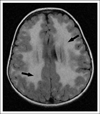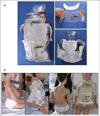Consensus statement on standard of care for congenital muscular dystrophies
- PMID: 21078917
- PMCID: PMC5207780
- DOI: 10.1177/0883073810381924
Consensus statement on standard of care for congenital muscular dystrophies
Abstract
Congenital muscular dystrophies are a group of rare neuromuscular disorders with a wide spectrum of clinical phenotypes. Recent advances in understanding the molecular pathogenesis of congenital muscular dystrophy have enabled better diagnosis. However, medical care for patients with congenital muscular dystrophy remains very diverse. Advances in many areas of medical technology have not been adopted in clinical practice. The International Standard of Care Committee for Congenital Muscular Dystrophy was established to identify current care issues, review literature for evidence-based practice, and achieve consensus on care recommendations in 7 areas: diagnosis, neurology, pulmonology, orthopedics/rehabilitation, gastroenterology/ nutrition/speech/oral care, cardiology, and palliative care. To achieve consensus on the care recommendations, 2 separate online surveys were conducted to poll opinions from experts in the field and from congenital muscular dystrophy families. The final consensus was achieved in a 3-day workshop conducted in Brussels, Belgium, in November 2009. This consensus statement describes the care recommendations from this committee.
Conflict of interest statement
Declaration of Conflicting Interests The authors declared no potential conflicts of interest with respect to the authorship and/or publication of this article.
Figures



Similar articles
-
Consensus statement on standard of care for congenital myopathies.J Child Neurol. 2012 Mar;27(3):363-82. doi: 10.1177/0883073812436605. J Child Neurol. 2012. PMID: 22431881 Free PMC article.
-
Diagnostic approach to the congenital muscular dystrophies.Neuromuscul Disord. 2014 Apr;24(4):289-311. doi: 10.1016/j.nmd.2013.12.011. Epub 2014 Jan 9. Neuromuscul Disord. 2014. PMID: 24581957 Free PMC article.
-
Differentiating Congenital Myopathy from Congenital Muscular Dystrophy.Clin Perinatol. 2020 Mar;47(1):197-209. doi: 10.1016/j.clp.2019.10.005. Epub 2019 Oct 11. Clin Perinatol. 2020. PMID: 32000926 Review.
-
Congenital myopathies and muscular dystrophies.Neurol Clin. 2014 Aug;32(3):689-703, viii. doi: 10.1016/j.ncl.2014.04.006. Neurol Clin. 2014. PMID: 25037085 Review.
-
173rd ENMC International Workshop: congenital muscular dystrophy outcome measures 5-7 March 2010, Naarden, The Netherlands.Neuromuscul Disord. 2011 Jul;21(7):513-22. doi: 10.1016/j.nmd.2011.04.004. Epub 2011 Jun 8. Neuromuscul Disord. 2011. PMID: 21641800 Free PMC article. No abstract available.
Cited by
-
The influence of viral respiratory season on perioperative outcomes in patients undergoing spinal fusion for neuromuscular scoliosis.Spine Deform. 2023 Mar;11(2):407-414. doi: 10.1007/s43390-022-00593-7. Epub 2022 Oct 7. Spine Deform. 2023. PMID: 36205854
-
Neurology of inherited glycosylation disorders.Lancet Neurol. 2012 May;11(5):453-66. doi: 10.1016/S1474-4422(12)70040-6. Lancet Neurol. 2012. PMID: 22516080 Free PMC article.
-
Longitudinal changes in clinical outcome measures in COL6-related dystrophies and LAMA2-related dystrophies.Neurology. 2019 Nov 19;93(21):e1932-e1943. doi: 10.1212/WNL.0000000000008517. Epub 2019 Oct 25. Neurology. 2019. PMID: 31653707 Free PMC article.
-
Congenital or Early Developing Neuromuscular Diseases Affecting Feeding, Swallowing and Speech - A Review of the Literature from January 1998 to August 2021.J Neuromuscul Dis. 2022;9(5):581-596. doi: 10.3233/JND-210772. J Neuromuscul Dis. 2022. PMID: 35848032 Free PMC article. Review.
-
Understanding the experiences and needs of individuals with Spinal Muscular Atrophy and their parents: a qualitative study.BMC Neurol. 2015 Oct 24;15:217. doi: 10.1186/s12883-015-0473-3. BMC Neurol. 2015. PMID: 26499462 Free PMC article.
References
-
- Strauss RP, Sharp MC, Lorch SC, Kachalia B. Physicians and the communication of “bad news”: parent experiences of being informed of their child’s cleft lip and/or palate. Pediatrics. 1995;96(1, pt 1):82–89. - PubMed
-
- Noeker M. Epilepsy—improvement of giving the diagnosis between the demands for standardisation versus individualisation. Seizure. 2004;13:95–98. - PubMed
-
- Muntoni F, Guicheney P. 85th ENMC International Workshop on Congenital Muscular Dystrophy. 6th International CMD Workshop. 1st Workshop of the Myo-Cluster Project GENRE. 27–28th October 2000, Naarden, The Netherlands. Neuromuscul Disord. 2002;12:69–78. - PubMed
Publication types
MeSH terms
Grants and funding
LinkOut - more resources
Full Text Sources
Medical

